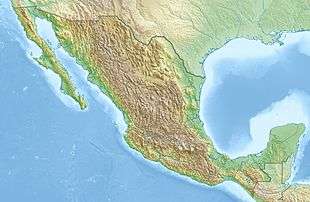Chan Hol
 Location in Mexico  Chan Hol (Mexico) | |
| Location | Quintana Roo, Mexico |
|---|---|
| Coordinates | 20°9′N 87°34′W / 20.150°N 87.567°WCoordinates: 20°9′N 87°34′W / 20.150°N 87.567°W |
Chan Hol, part of the Toh ha cave system, is a cenote and submerged cave system in Quintana Roo, Mexico, of interest to paleoanthropologists. The remains of two prehistoric human fossils were discovered within the cave system. Along with Eve of Naharon, Naia, the Man of El Templo and the Woman of Las Palmas, the two fossils at Chan Hol are among several ancient Paleoamerican skeletons found in the submerged cave systems of the Yucatán Peninsula around Tulum, Quintana Roo.[1]
Description
Chan Hol is derived from Mayan, meaning "little hole".[2] The Chan Hol cave system extends over 5,000 m (16,404 ft) in length. The entrance, via the cenote, is located around 15 km (9 mi) away from Tulum and around 11.5 km (7 mi) from the modern coastline.[3] As the sea level was over 100 m (328 ft) lower than it is today, the cave system was dry during the Late Pleistocene.[3] During the Late Pleistocene, the Yucatán region was likely composed of dry savanna, grassland and even desert.[1]
Human fossils
The skeletons of two ancient Paleoamericans were discovered within the Chan Hol cave system. Both skeletons exhibit sinodont dental morphology.[4]
Chan Hol I
The first fossil, Chan Hol I, was discovered in 2006 by Alexandra and Thorsten Kampe at a location in the cave system around 530 m (1,739 ft) northeast of the cenote entrance, at a depth of around 8 m (26 ft) underwater. Nicknamed El Joven, the fossil is dated to around 9194-8792 BP. The skeleton had fossilized while the cave system was still dry.[3] The skeleton shows evidence of intentional placement of the dead body.[1]
Chan Hol II
The second fossil, Chan Hol II, was discovered in 2009 by Harry Gust[3] at a location in the cave system around 1,240 m (4,068 ft) southwest of the cenote entrance, at a depth of around 8.5 m (28 ft) underwater.[5] In February 2012, photos of the skeleton spread on social media.[5] In March 2012, the site was vandalized and looted.[5] Most of the skeletal remains, including the skull, were stolen. In October 2012, researchers collected the leftover fossil fragments from the site.[3] Although Chan Hol II was given the nickname La Niña,[3], later osteological analysis shows that the remains likely belonged to a young male.[5] The fossil is dated to around 11,311 BP.[5] The individual had died while the cave system was still dry.[3]
References
Citations
Bibliography
- Braswell, Geoffrey (2014). The Ancient Maya of Mexico : Reinterpreting the Past of the Northern Maya Lowlands. London New York: Routledge, Taylor & Francis Group. ISBN 1-317-54360-2.
- González, Arturo H.; Terrazas, Alejandro; Stinnesbeck, Wolfgang; Benavente, Martha E. (2014). "Chapter 19: The First Human Settlers on the Yucatan Peninsula: Evidence from Drowned Caves in the State of Quintana Roo (South Mexico)". In Graf, Kelly. Paleoamerican odyssey. College Station: Texas A & M University Press. p. 399-413. ISBN 1-62349-192-4.
- Stinnesbeck, Wolfgang; Becker, Julia; Hering, Fabio; Frey, Eberhard; González, Arturo González; Fohlmeister, Jens; Stinnesbeck, Sarah; Frank, Norbert; Terrazas Mata, Alejandro; Benavente, Martha Elena; Avilés Olguín, Jerónimo; Aceves Núñez, Eugenio; Zell, Patrick; Deininger, Michael (2017-08-30). Petraglia, Michael D., ed. "The earliest settlers of Mesoamerica date back to the late Pleistocene". PLOS ONE. Public Library of Science (PLoS). 12 (8). doi:10.1371/journal.pone.0183345. ISSN 1932-6203.
- "Undersea Cave Yields One of Oldest Skeletons in Americas". National Geographic News. 2010-09-15. Retrieved 2017-08-31.